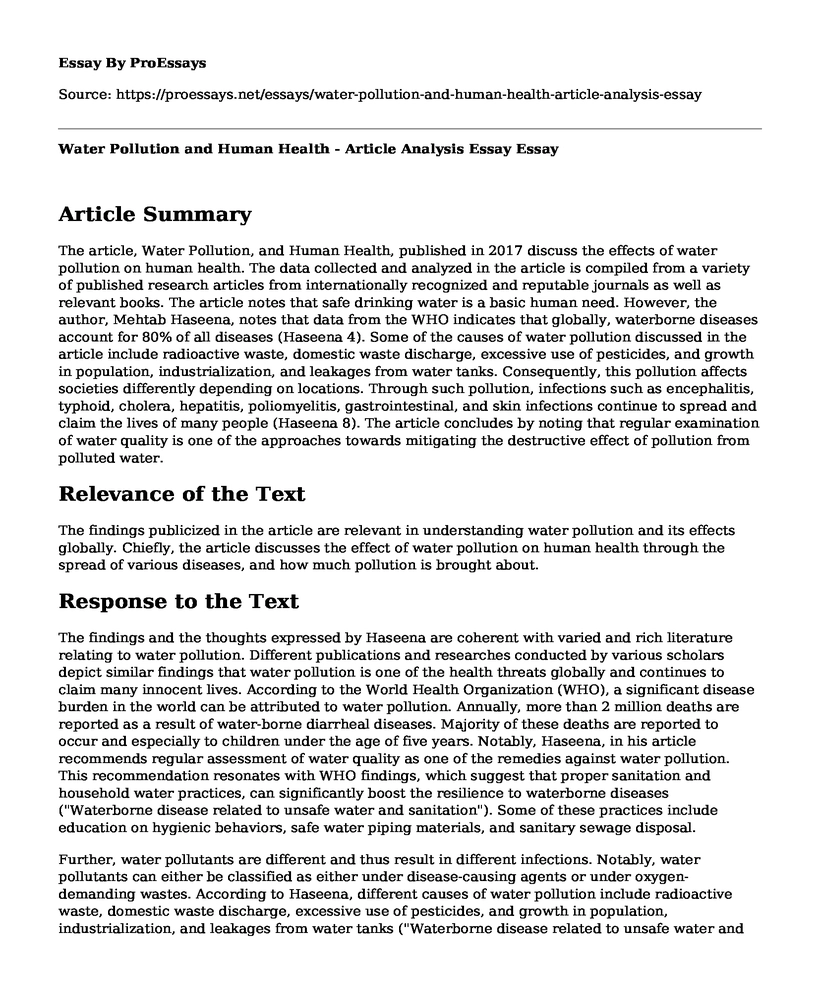Article Summary
The article, Water Pollution, and Human Health, published in 2017 discuss the effects of water pollution on human health. The data collected and analyzed in the article is compiled from a variety of published research articles from internationally recognized and reputable journals as well as relevant books. The article notes that safe drinking water is a basic human need. However, the author, Mehtab Haseena, notes that data from the WHO indicates that globally, waterborne diseases account for 80% of all diseases (Haseena 4). Some of the causes of water pollution discussed in the article include radioactive waste, domestic waste discharge, excessive use of pesticides, and growth in population, industrialization, and leakages from water tanks. Consequently, this pollution affects societies differently depending on locations. Through such pollution, infections such as encephalitis, typhoid, cholera, hepatitis, poliomyelitis, gastrointestinal, and skin infections continue to spread and claim the lives of many people (Haseena 8). The article concludes by noting that regular examination of water quality is one of the approaches towards mitigating the destructive effect of pollution from polluted water.
Relevance of the Text
The findings publicized in the article are relevant in understanding water pollution and its effects globally. Chiefly, the article discusses the effect of water pollution on human health through the spread of various diseases, and how much pollution is brought about.
Response to the Text
The findings and the thoughts expressed by Haseena are coherent with varied and rich literature relating to water pollution. Different publications and researches conducted by various scholars depict similar findings that water pollution is one of the health threats globally and continues to claim many innocent lives. According to the World Health Organization (WHO), a significant disease burden in the world can be attributed to water pollution. Annually, more than 2 million deaths are reported as a result of water-borne diarrheal diseases. Majority of these deaths are reported to occur and especially to children under the age of five years. Notably, Haseena, in his article recommends regular assessment of water quality as one of the remedies against water pollution. This recommendation resonates with WHO findings, which suggest that proper sanitation and household water practices, can significantly boost the resilience to waterborne diseases ("Waterborne disease related to unsafe water and sanitation"). Some of these practices include education on hygienic behaviors, safe water piping materials, and sanitary sewage disposal.
Further, water pollutants are different and thus result in different infections. Notably, water pollutants can either be classified as either under disease-causing agents or under oxygen-demanding wastes. According to Haseena, different causes of water pollution include radioactive waste, domestic waste discharge, excessive use of pesticides, and growth in population, industrialization, and leakages from water tanks ("Waterborne disease related to unsafe water and sanitation"). The categorization of these causes identifies disease-causing agents like viruses, bacteria, parasitic worms and protozoa that find their way into water bodies either through untreated waste or sewage systems (Denchak). The oxygen-demanding pollutants, on the other hand, include those wastes whose decomposition is by oxygen-requiring bacteria, depleting oxygen in water bodies. These pollutants are reportedly prevalent in regions which have poor sanitary conditions (Remoundou and Koundouri 2167). As a result, extreme care and hygiene ought to be maintained in order to mitigate the effect of such diseases. In tropic regions, for example, the number mortality rates as a result of waterborne diseases are relatively high, with infections such as cholera, hepatitis, typhoid, and dysentery being most common in such areas.
Works Cited
Denchak, Melissa. "Water Pollution: Everything You Need to Know." NRDC, 14 May 2018, www.nrdc.org/stories/water-pollution-everything-you-need-know. Accessed 9 Apr. 2019.
Haseena, Mehtab. "Water pollution and human health." Environmental Risk Assessment and Remediation, vol. 1, no. 3, 13 July 2017, doi:10.4066/2529-8046.100020. Accessed 9 Apr. 2019.
Remoundou, K., and P. Koundouri. "Environmental Effects on Public Health: An Economic Perspective." International Journal of Environmental Research and Public Health, vol. 6, no. 8, 2009, pp. 2160-2178, doi:10.3390/ijerph6082160.
"Waterborne disease related to unsafe water and sanitation." www.who.int/sustainable-development/housing/health-risks/waterborne-disease/en/. Accessed 9 Apr. 2019.
Cite this page
Water Pollution and Human Health - Article Analysis Essay. (2022, Dec 22). Retrieved from https://proessays.net/essays/water-pollution-and-human-health-article-analysis-essay
If you are the original author of this essay and no longer wish to have it published on the ProEssays website, please click below to request its removal:
- Paper Example on Use of Pharmaceutical Cognitive Enhancers
- Nurse Educator Philosophy Statement Paper Example
- Melanoma Skin Cancer - Essay Sample
- Research Paper on Social Work: Preventing Social Exclusion & Inclusion for Deviant Behaviors
- Essay on Sustainable Measures Needed: Curbing Global Environmental Degradation
- Essay Example on Fragmentation in US Healthcare System: Effects and Examples
- Critical Appraisal: A Must in the Medical Field - Free Report Example







